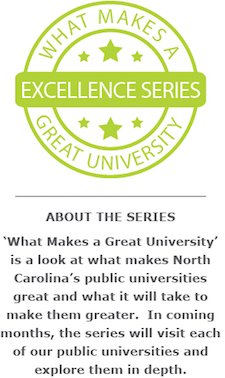 ASHEVILLE – UNC Asheville is the only institution in the University of North Carolina System that offers Mechatronics Engineering, which combines the disciplines of engineering and computer science with design, art and sculpture.
ASHEVILLE – UNC Asheville is the only institution in the University of North Carolina System that offers Mechatronics Engineering, which combines the disciplines of engineering and computer science with design, art and sculpture.
“It’s a creative collision,” Chancellor Mary Grant says in the accompanying video. “It’s asking the question, ‘What’s the problem we’re trying to solve?’ instead of just coming in and fixing something.”
Offered in collaboration with NC State University, the program combines instructors from different fields in a team-teaching approach. A team of students in a creative fabrication class tasked with solving a human mobility challenge, for example, designed a cane last year that used an eagle talon to make it more stable.
“They were not only functional; they were esthetically beautiful,” Grant says.
“So when you bring together the different disciplines, the results are magnificent. And they’re really preparing our students for the way they’re going to work in the 21st century – in partnerships and teams, using innovation and being curious about what somebody else does and what they can bring to bear to solve the problem.”
STEAM Studio (Science, Technology, Engineering, Arts and Math)
Much of the work in Mechatronics Engineering takes place at STEAM Studio, a makerspace that UNC Asheville opened just off campus in late 2016.
When administrators asked faculty from different disciplines to design the studio, Grant says, they asked, “Let’s imagine a 21st century classroom – what do we need? Most importantly, what do our students need?
“It’s much more than a classroom – it’s a space for us to be exploring, it’s a space for us to be creating, and it’s a space for us to be building partnerships.”
Students at STEAM Studio use state-of-the-art equipment such as a water jet that pressurizes water to 50,000 pounds per square inch to cut through objects 12 inches thick – or through 3/8-inch steel to create a kidney-shaped desk top.
“What goes on at STEAM Studio is basically a nexus of art and science,” says Brent Skidmore, Associate Professor of Art and Art History. “(It’s) a place where our students can come together and really have interdisciplinary experience, collaborative moments that they might not have if they stayed in each of their separate disciplines.”
Grant sees “creative collision” happening.
“It’s really something that belongs to the heart of the enterprise, which is education and teaching and learning and curiosity,” she says, “and it’s a very special space.”

Leave a Reply